My goldwork embroidery project – a stylized pomegranate – is chugging along rather slowly! After finishing the passing threads on the turn-under tips of the “petals,” there were only two more things that needed to be done in order to call the fruit finished: outlining a bit more with check thread, and taking care of the neck clasp at the top of the fruit.
Since I’ve already covered working with check thread – a wavy, real metal thread used in goldwork – you may want to read the previous article on it. I’m not going to go into deep detail here with the check thread! As a matter of fact, this last part was really easy, as it was just a matter of outlining.
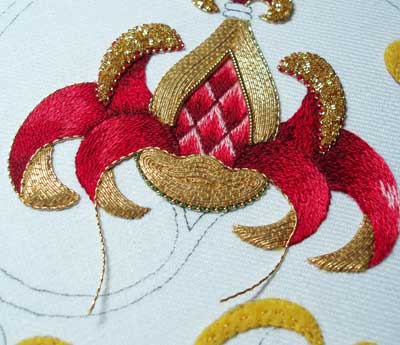
In the photo above, you can see that I’ve already outlined one petal on the far left. Now it’s time to add the top edge to the center “bowl” of the fruit, and that edge is done with check thread, which carries over to the lower edge of the petals on both sides of the bowl.
To work the outline in the check thread, I picked out the longest continual lines, worked those, and then went back and worked the shorter broken lines.
All the “petals” of the fruit are outlined with the check thread.
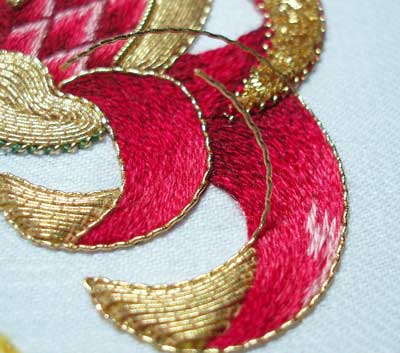
If you concentrate on this petal – the largest one on the right of the fruit – you can see that I picked the longest outline edge, starting from the origin of the petal (where it meets that other petal in the background of the photo), bringing it forward along the top edge of the petal, working around the tip of the turn-under (pinching with tweezers to take the corner), and then ending at the end of the turn-under. The next piece of check thread will cover the rest of the outline – the lower edge of the petal, into the petal above the turn-over.
I left at least an inch of thread at each end of the check thread, to take care of plunging.
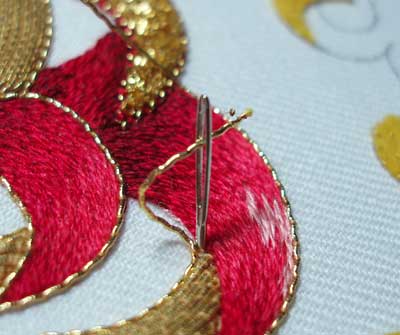
I plunged the check thread right in the corner, where petal and turn-over meet. Again (as mentioned in earlier posts on this project), I am using a chenille needle to plunge the threads, since the check thread is relatively fine and fits easily into the eye of the needle.
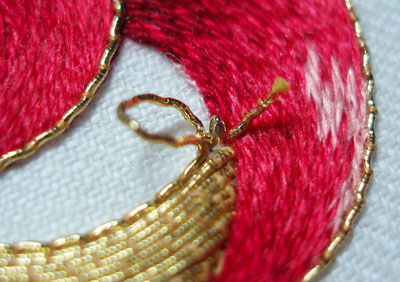
You can see the tip of the eye of the needle here, taking one last gasp before plunging to the back. When using a needle to plunge your threads, you might have to wiggle it gently back and forth to get the needle and the metal thread to pop to the back.
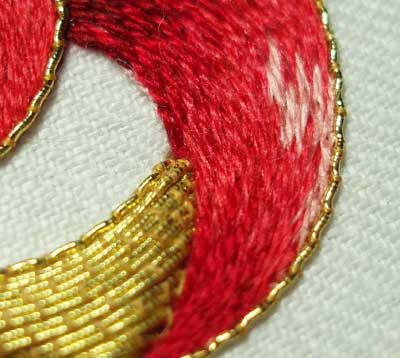
All gone! The next piece of check thread will be worked right along the edge of the petal there, and then right along the passing thread on the turn-under.
And all the remaining edges of the petals were duly outlined with check thread…
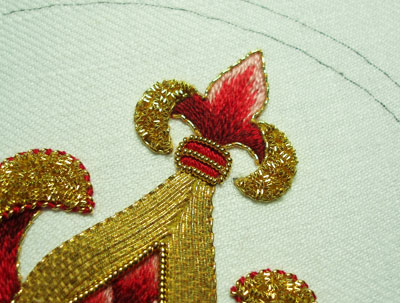
Then I went up and took care of the little neck clasp. I satin stitched the two ‘bars’ that were drawn there in the medium shade of red silk, and then ran a little snippet of pearl purl through the center area of the clasp, and then outlined the clasp with pearl purl, manipulating it around the corners without bending it square. You can actually bend pearl purl into a very nice 90-degree angle, but I didn’t want sharp edges here.
I subsequently started poking around the pearl purl, trying to get it where I wanted it after stitching it on there, and managed a disturbing kink in the metal on the lower edge of the clasp. I’ll fix that up at the end – nothing a bit of manipulating can’t take care of, or, at the worst, I might have to replace that bit of pearl purl.
So here it is, the fruit complete:
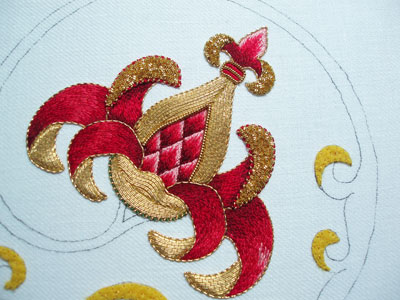
Now, on to the stem. One thing I’ve already discovered about the stem: it’s a larger area than I thought, when it comes to filling in with the green silk!
For all the posts in this series, please visit the following links, which are arranged in the order of the project’s development:
Stylized Pomegranate Pattern used for this project
Setting up the Project on a Frame
Preparing the Ground Fabric with Felt Padding
Selecting Colors of Silk for the Project
The Stitching Begins – SIlk Shading
Continuing the silk shading – the left side
Finishing the silk shading
The Goldwork Begins: Smooth Passing Thread
Check Thread for Outlining
Chip Work Filling with Check Purl
Outlining with Stretched Pearl Purl
Filling the Bowl with Passing Thread
Finishing the Tips with Passing Thread
Finishing the Fruit
Beginning the Stem
Continuing with the Green on the Stem
Almost finished! Chip work on the Stem
The Finished Goldwork Pomegranate







Just one word: Exquisite !!!!! Elza bester Cape Town xxx
Oh, it looks so neat!
Beautiful. Thank you for sharing such beautiful work in all detail.
I really enjoy your blog. I will be trying some goldwork soon, when my ordered kit arrives.
Larissa, Moscow
"Chugging along rather slowly"?? Oh, Mary, if only you knew! My projects? Well, you could say they are rusting slowly in the trainyard!
Beautiful work!! Hehe, in the beginning I thought you meant you had the whole thing done! I was thinking, "what, already? Man she's quick." Silly me.
G'day Mary,
"So here it is, the fruit complete:"
Completely beautiful.
Cheers, Kath.
Oh, I loooooove it.
Love the neck clasp!
Stunning! And I've learned so much following this project. Thank you again for sharing your talent and your knowledge (as well as the mistakes, that show us we are all capable of re-working or fixing things!).
Smiles,
Gorgeous, Mary – it looks wonderfully rich and exotic!
Absolutely stunning. I really like how you have contrasted the silk stitching and the Goldwork in the neck clasp. Thanks Mary for being my inspiration.
Forgive my ignorance but I have a question about the check thread or any of the gold threads: You used a piece to go around the petal as far as you could go. Then you were going to use another separate piece to finish up under the petal and across the other gold threads. Is it possible to plunge the check thread as you did and (if the thread was long enough) bring it up again to the surface and finish the outlining? It's not a long distance to run on the back side but perhaps you can't do that with gold. It would save some starts and stops with bits of thread.
Hi, Irene –
That's a good question! It would be nice if that could work out, but the plunging really takes a lot out of the thread – by the time it gets pulled to the back, it doesn't look so great. Also – and I could be wrong about this, because I haven't tried it – but, picturing it, I think the angle on the thread would not be so good. That folding under of the end keeps the finish angle on the thread fairly sharp. If the thread stretches across to another point to go up, it will pull the top thread in that direction and perhaps mess up finish on the plunged end of the thread.
But I think the strongest argument against it, with this size thread, is that plunging takes a toll on the thread and messes it up quite a bit.
Hope that helps!
MC
I like very much the tip of the fruit. I don't know if it is because of the photo, but my preference goes for the fruit before the addition of the check thread at the edge of the long and short red "petals". The beautiful shading you made between each petal is loosing its effect. That's all very personal thought. Each person has personal taste and that makes the world so rich.
This is a beautiful piece of art!
I learned a lot about goldwork, the different sizes and shapes, how to lie them down and where to use them. Thank you for your hard work and well taught design.
Debra Pumaundme